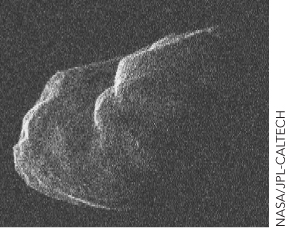19 Public Goods and the Tragedy of the Commons
CHAPTER OUTLINE
Four Types of Goods
Private Goods and Public Goods
Club Goods
Common Resources and the Tragedy of the Commons
Takeaway
Appendix: The Tragedy of the Commons: How Fast?
Armageddon almost happened on September 29, 2004. We aren’t talking about the final battle described in the Bible, but what happened in Armageddon the movie. In Armageddon, an asteroid is discovered to be on a collision course with Earth and NASA recruits a group of roughneck oil drillers to rocket into space, deflect the asteroid, and save civilization. Armageddon the movie is a bit absurd, but it got a few things right. Even an asteroid the size of an apartment building would hit Earth with the force of a 4-megaton nuclear bomb. On September 29, 2004, an asteroid called Toutatis, 2.9 miles long by 1.5 miles wide, narrowly missed Earth. If Toutatis had hit, it would have meant the end of civilization.

The probability of death by asteroid is remarkably high, by some calculations about the same as death by passenger aircraft crash. How can this be? Although the probability of an asteroid hitting Earth is very small, a lot of people would be killed if one did hit, so the probability of death by asteroid is much larger than most people imagine. It doesn’t happen very often but watch out when it does.*
Let’s assume that we have convinced you that the danger from an asteroid collision is real and thus that asteroid deflection would be a valuable good to have. Markets provide us with all kinds of valuable goods like food, clothing, and cell phones, but you can’t buy asteroid deflection in the market. Even if everyone were to become convinced of the benefits of asteroid deflection, you probably will never be able to buy asteroid deflection in the market. To see why, we need to take a closer look at some of the common properties of ordinary goods and some of the special properties of asteroid deflection.
When you spend $100 on a new pair of jeans, you get the exclusive use of a new pair of jeans. If you don’t spend $100 on a new pair of jeans, you are excluded from using the jeans. In other words, the $100 makes a big difference in whether or not you get the jeans. That’s obvious.
Now consider paying $100 toward asteroid deflection. What do you get for your $100? There are really only two situations to consider: Either enough other people pay for asteroid deflection so that the asteroid will be deflected even without your $100 or so few other people pay that the asteroid will not be deflected even with your $100.* Either way, your $100 makes no appreciable difference in the amount of asteroid deflection that you will receive. In other words, you get the same amount of asteroid deflection whether you pay or don’t pay.
Since your $100 doesn’t get you more asteroid deflection but it does get you a new pair of jeans, most people will buy the jeans rather than the asteroid deflection. As a result, we see a lot of firms selling jeans and none selling asteroid deflection. That’s a problem because asteroids are a threat to everyone on the planet.
Jeans are an example of a private good. Asteroid deflection is an example of what economists call a public good, a good that markets are unlikely to produce in efficient quantities. Let’s look more closely at these terms and the differences between jeans and asteroid deflection.
